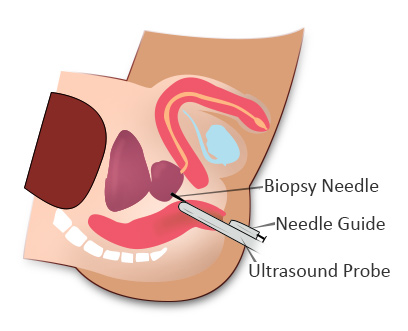What is a Prostate Biopsy?
 The prostate is a walnut-shaped gland located below the bladder that secretes fluid to nourish sperm. A prostate biopsy is a procedure used to remove tissue samples from a man’s prostate to test for prostate cancer.
The prostate is a walnut-shaped gland located below the bladder that secretes fluid to nourish sperm. A prostate biopsy is a procedure used to remove tissue samples from a man’s prostate to test for prostate cancer.
During a prostate biopsy procedure, the urologist will apply local anaesthesia to numb the area around the prostate. The urologist will then use a needle guided by an ultrasound probe to collect samples of prostate tissue.
The entire procedure usually takes about 20 to 30 minutes.
Types of Prostate Biopsy
There are two main types of prostate biopsy:
Transrectal Biopsy
This is the most common procedure and is done by inserting a needle through the rectum wall to extract prostate tissue samples.
Transperineal Biopsy
A small incision is made between the anus and the scrotum. A needle will then be inserted through the incision and into the prostate to extract the prostate tissue samples. This procedure is usually guided by an MRI or CT scan.
What happens after a prostate biopsy?
After a prostate biopsy, you will need to wait for a few hours to recover from the anaesthetic’s effects. Your urologist may advise you to avoid strenuous activities for at least 48 hours after the procedure. You may also be prescribed antibiotics to reduce the risk of infection.
Depending on your health condition, the recovery process after a biopsy may take about four to six weeks, or even longer.
What are the side effects and complications?
Some common side effects after a prostate biopsy include:
- Soreness
- Slight bleeding from the rectum
- Blood in your urine, stools or semen
- Frequent urination
- Burning sensation when urinating
The above symptoms are considered normal and may subside after a few days.
However, there are certain risks and complications involved with a biopsy. Please consult your urologist immediately should you experience the following symptoms:
- Fever
- Difficulty in urinating
- Bleeding for a prolonged period
- Worsening pain
Prostate Biopsy Result
The doctor will evaluate whether the prostate cells are cancerous based on the biopsy findings. If the biopsy result is positive, it means there are cancer cells in the obtained tissue. If the biopsy result is negative, it means there are no cancer cells found in the biopsy samples.
The Gleason grading system uses prostate biopsy samples to assess the prognosis of men with prostate cancer. It determines the stage and aggressiveness of the cancer based on the Gleason score from the biopsy report. The higher the Gleason score, the more likely the cancer have spread outside the prostate.
| Risk Group | Grade Group | Gleason Score |
|---|---|---|
| Low / Very low | Group 1 | 3 + 3 = 6 |
| Intermediate | Group 2 | 3 + 4 = 7 |
| Group 3 | 4 + 3 = 7 | |
| High / Very high | Group 4 | 4 + 4 = 8 |
| Group 5 | 9 to 10 |
A Gleason score of six is considered a low grade, and a score of seven is an intermediate grade. A score of eight to 10 is a high grade that places you at a higher risk of cancer recurrence.
The doctor will also refer to your biopsy results to determine the type of prostate cancer you have.
After receiving your biopsy results, discuss with your doctor to determine the next course of action for your condition.
Make An Appointment
Make an appointment online to consult a urologist at Raffles Urology Centre. To make an appointment, select "Specialist Appointment". Under Specialist Appointment Details, select "Urology".
Make an enquiry. We will get back to you within 2 working days. You can reach us at 6311 2100.